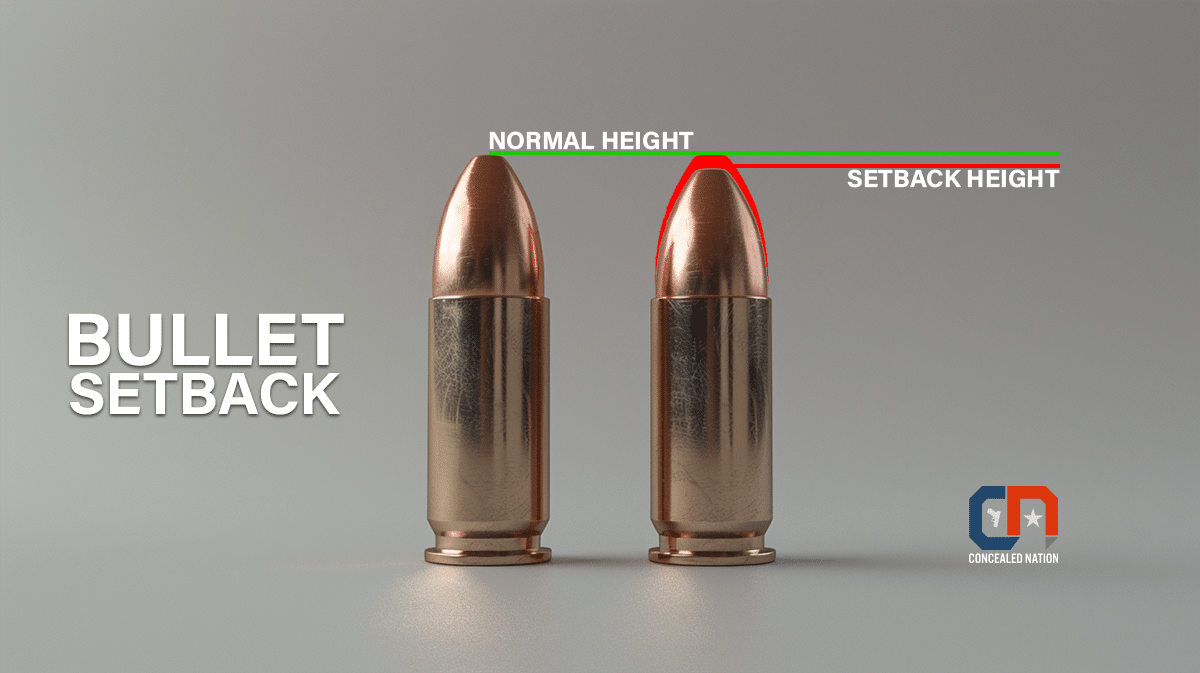Bullet setback is a phenomenon where the bullet is pushed deeper into the cartridge case, leading to increased pressure when fired. This article explores the risks associated with it, debunks myths, and offers practical tips for prevention to ensure firearm safety.
What is Bullet Setback? First off, it’s not fiction, and is a critical issue that every firearm owner and enthusiast should be aware of. This phenomenon occurs when the bullet is pushed back into the cartridge case, resulting in decreased overall length and increased pressure when the round is fired. Understanding the causes, risks, and preventive measures associated with this issue is crucial for maintaining firearm safety and preventing accidents.
What is Bullet Setback?
Bullet setback happens when a bullet is pushed further back into the cartridge case than originally intended. This usually occurs due to repeated chambering of the same round, improper handling, or manufacturing defects. When the bullet is seated deeper into the case, it reduces the volume available for the powder to burn, leading to a significant increase in chamber pressure when the round is fired.
Causes
Several factors can contribute to this issue, including:
- Repeated Chambering: Every time a round is chambered and then ejected without firing, there is a potential for the bullet to be pushed back slightly. Over time, repeated chambering of the same round can lead to significant setback.
- Improper Handling: Dropping or mishandling ammunition can cause the bullet to be pushed deeper into the case.
- Manufacturing Defects: Occasionally, ammunition may be produced with inadequate neck tension or crimping, making it more susceptible to setback.
- Firearm Design: Some firearms have feed ramps that can be more aggressive, increasing the likelihood of setback during the chambering process.
Risks Associated with Bullet Setback
The primary risk is the dramatic increase in chamber pressure. This can lead to several dangerous situations:
- Increased Pressure: When the bullet is pushed back, the powder burns in a smaller volume, causing pressure to spike. This can exceed the firearm’s design limits, potentially causing catastrophic failure.
- Firearm Damage: Excessive pressure can damage the firearm, leading to cracked or blown barrels, damaged chambers, and other mechanical failures.
- Personal Injury: High-pressure rounds can cause serious injury to the shooter or bystanders due to firearm malfunction or exploding cartridges.
- Reduced Accuracy: Setback rounds can result in inconsistent ballistic performance, leading to reduced accuracy and reliability.
Is Bullet Setback a Myth?
No, it is not a myth. It is a real and documented phenomenon that can have severe consequences if not properly addressed. While some may dismiss it as a minor issue, the potential for increased pressure and the resulting dangers make it a critical concern for anyone handling firearms. Understanding and preventing it from happening is essential for maintaining firearm safety and ensuring reliable performance.
How To Prevent It
Preventative measures involve a combination of proper ammunition handling, routine inspection, and following best practices for firearm maintenance. Here are some key tips to prevent it from happening:
- Limit Rechambering: Avoid repeatedly chambering the same round. If you need to unload your firearm, rotate the top round in the magazine to ensure even wear.
- Inspect Ammunition: Regularly inspect your ammunition for signs of setback. Measure the overall length of rounds and compare them to factory specifications.
- Use Quality Ammunition: Invest in high-quality ammunition from reputable manufacturers. Quality control measures in place by reputable brands reduce the likelihood of manufacturing defects.
- Proper Storage: Store ammunition in a cool, dry place to prevent degradation. Use ammo boxes or containers to protect rounds from physical damage.
- Firearm Maintenance: Keep your firearm clean and well-maintained. Ensure that the feed ramp and chamber are free from obstructions that could cause setback during chambering.
The design of a firearm can also influence the likelihood of bullet setback. Firearms with steep or rough feed ramps may be more prone to causing setback during the chambering process. Manufacturers continuously work on improving designs to minimize this risk. Users should be aware of their firearm’s characteristics and take appropriate measures to mitigate setback risks.
Myths and Misconceptions
There are several myths and misconceptions surrounding this phenomenon. It’s important to debunk these to provide accurate information:
- Myth: Setback Only Affects High-Caliber Rounds: Bullet setback can affect any caliber. The severity of the impact may vary, but the phenomenon is not limited to high-caliber rounds.
- Myth: Setback is Not a Serious Issue: Even minor setback can lead to significant pressure increases. It should always be taken seriously.
- Myth: All Ammunition is Prone to Setback: Quality ammunition from reputable manufacturers with proper crimping and neck tension is less likely to experience setback.
Real-Life Examples
There have been several documented cases of bullet setback leading to firearm malfunctions and injuries. These real-life examples highlight the importance of understanding and preventing this issue:
- Case Study 1: A shooter experienced a catastrophic failure in their semi-automatic pistol due to bullet setback. The repeated chambering of the same round caused significant setback, leading to an overpressure event that destroyed the firearm and injured the shooter.
- Case Study 2: In another incident, a competitive shooter noticed a sudden drop in accuracy. Upon inspection, several rounds showed signs of setback. This discovery prevented a potential accident and highlighted the importance of regular ammunition checks.
Conclusion
Bullet setback is a genuine concern for firearm owners and users. This phenomenon, though sometimes misunderstood or underestimated, poses significant risks if not properly managed. Understanding the causes, risks, and prevention methods is essential for maintaining firearm safety and ensuring reliable performance.
Implementing Preventive Measures
Preventing bullet setback involves adopting best practices in ammunition handling, storage, and firearm maintenance. Remember the following:
- Limit Rechambering
- Regular Ammunition Inspection
- Use Quality Ammunition
- Proper Storage Conditions
- Maintain Your Firearm
Safety Tip: Always inspect your ammunition for signs of bullet setback before use. Regularly measure the overall length of your rounds and compare them to factory specifications to ensure they have not been compromised.
Read the full article here




